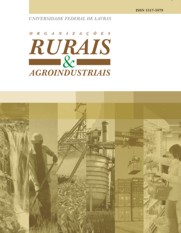CONSADS of Brazil: A Study from Rural Development Index and Multiple Analysis Factor
Keywords:
Inequality, Trajectory, Rural DevelopmentAbstract
The objective of this study is to analyze the rural development trajectory in the municipalities belonging to the Consortium on Food Security and Local Development (CONSAD) in Brazil in the years 2000 and 2010, using two methods: the rural development index and factorial analysis, in order to measure and compare the development of the CONSADs and to analyze the evolution of these localities with the implementation of the program, suggesting future policies and new studies in relation to the theme. The rural development index is related to population, social welfare, economic development, and the environment. The results indicate that, in general, the CONSAD program was beneficial to its municipalities, with an increase in the Rural Development Index in almost all CONSADs in Brazil during the years 2000 and 2010. As for the subindices, the evolution was different between the regions. The sub index was only developed in the Center-West region. The South region presented evolved economic development and the North region presented increased environment. The only sub index that has evolved in all regions was social welfare, showing that CONSAD’s strategy for building human capital was beneficial to all CONSADs in Brazil.


